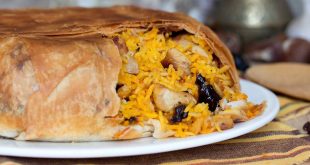Azerbaijani national cuisine is very diverse and has dozens of different types of dairy, meat, flour, vegetable dishes. Such a diversity was influenced by the geographical conditions and social status of people. The mountainous and subtropical climate has caused a wide distribution of mutton, poultry, river and sea (Caspian) fish, as well as fruits and vegetables in the Azerbaijani cuisine. Spices and seasonings are widespread, as well as a variety of herbs – parsley, green and black basil, dill, cilantro, green onions, mint, watercress, coriander, bitter and allspice, celery, tarragon, leek, sour cream and etc.
Meat
Shish kebabs and dishes in tandir are more widely spread in Azerbaijani cuisine. Therefore, in many restaurants of the traditional direction in the first place the will offer exactly these dishes. A distinctive feature of the Azerbaijani cuisine is the use of lamb for cooking various dishes. Azerbaijanis consume beef, poultry, and fish to a much lesser extent.
Fruits and vegetables
Azerbaijani cooking makes extensive use of vegetables (tomatoes, cucumbers, eggplants, and others), fruits (apples, pears, quince, oranges, lemons), stone fruits (plums, cherry plums, apricots, peaches).
Spices
Another feature of Azerbaijani cooking is the spicy taste and unique aroma that give the dishes various spices and greens: bitter and allspice, basil, cinnamon, cloves, dill, parsley, cilantro, mint, cumin and many others. Sumac is usually served with various meat dishes.
Some notable dishes
Piti. Some dishes of the Azerbaijani cuisine are prepared in special dishes. For example, the soup called Piti is prepared in special clay pots. One such pot is one serving. Piti’s birthplace is the city of Sheki.

Saj. One of the most popular dishes of the Azerbaijani cuisine is Saj, which is an assorted meat and vegetables, in the preparation of which they use the frying pan of the same name, and Saj is served with a tiny brazier with hot coals installed under it. This maintains the hot temperature of the dish and allows it to cook even more after serving.

Dolma. Different types of dolma – stuffed grape leaves, cabbage, eggplants, tomatoes, bell peppers and even fruits, such as, for example, apple and quince, occupy a special place in the Azerbaijani cuisine.

Pilaf. One of the most popular dishes of the Azerbaijani cuisine is pilaf or plov. Azerbaijani cuisine has several types of pilaf. Ingredients include lamb, chicken, sour and sweet fruits, vegetables, pumpkin, chestnuts, greenery and seasonings. An indispensable component for the preparation of numerous pilavs is saffron. Pilafs are prepared in special boilers with a thickened bottom and covers. To steam pilaf evenly when cooking the use special techniques. Serving and eating Azerbaijani pilafs have their own traditions.

Lavangi. Another remarkable national dish in Azerbaijani cuisine is Lavangi. It is a fish, chicken, and even wildfowl stuffed with walnuts, onions and various condiments and baked in the oven or tandir. Lavangi is most common in the Absheron peninsula and in the Southern part of Azerbaijan – in Lankaran, Masalli, Astara, and Lerik districts.

Sweets and dessert
There are many sweets in the cuisine of Azerbaijan. These include Shekerbura, Baklava, Sheker-Churek, Kurabiye, Mutaki, and many more. A special place is occupied by Sheki sweets – Sheki Baklava, Peshvenk, Tel, Gyrmabadam, in the production of which the use rice flour, sugar, nut kernels, butter, eggs and spices.

Sherbet (Sorbet) drinks
Unlike Central Asian sherbet, those made here are primarily a sweet, or a dessert. Azerbaijani sherbets are soft drinks, and play the role of bevarage to accompany pilaf. In addition to fruit and berry juices, they also use tinctures and distillates of aromatic parts of plants — seeds, buds, and others as the main component, and the fruit base consists of juices of acidic fruits and berries.

The influence of Islam on Azerbaijani cuisine
The formation of the Azerbaijani cuisine was also influenced by the requirements of Islam – as a result, pork dishes and dishes containing alcohol were not traditionally represented in the Azerbaijani kitchen.
Interesting Facts
In March 2009, pastry chefs in Ganja had cooked a miracle baklava. The length of this confectionery baked in honor of the Novruz holiday was 12 meters, and its width was 4 meters. The weight of this pastry was about three tons. These figures allowed the Azerbaijani baklava to set a record and be included into the Book of Records of the CIS. In addition, this product of pastry claims a place in the Guinness Book of Records.
 Oval Useful news from Azerbaijan and Caucasus
Oval Useful news from Azerbaijan and Caucasus


